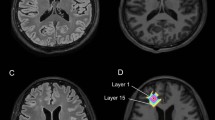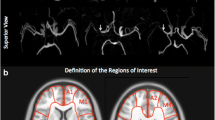Abstract
Objective
Cerebral microbleeds (CMBs), probably reflecting microangiopathy, have not yet sufficiently been examined in association with cerebral blood flow (CBF) and metabolism. We investigated the relationships between CMBs, and CBF and metabolism in symptomatic small vessel disease.
Methods
We enrolled 22 patients with symptomatic small vessel disease without severe stenosis (>50 %) in major cerebral arteries. Volumes of white matter lesions (WMLs) and number of CMBs were assessed on images of fluid-attenuated inversion recovery and gradient-echo T2*-weighted magnetic resonance imaging, respectively. Patients were divided into two groups according to the median number of CMBs (group I <5, n = 10; group II ≥5, n = 12). Parametric images of CBF, cerebral metabolic rate of oxygen (CMRO2), oxygen extraction fraction and cerebral blood volume were estimated using positron emission tomography and 15O-labeled gases. The functional values in the cortex–subcortex, basal ganglia, and centrum semiovale were compared between the two groups.
Results
Volumes of WMLs of group II were larger than those of group I (median: 38.4; range: 25.1–91.5 mL vs. median: 11.3; range: 4.2–73.4 mL, p = 0.01). In the centrum semiovale, the mean CBF of group II was significantly lower than that of group I (12.6 ± 2.6 vs. 15.6 ± 3.3 mL/100 g/min, p = 0.04). In the other regions, there were no significant differences in either CBF or CMRO2 between the two groups.
Conclusions
Our study indicated that increases in the number of CMBs with larger volumes of WMLs were associated with cerebral ischemia in the deep white matter in patients with symptomatic small vessel disease.

Similar content being viewed by others
References
Roob G, Schmidt R, Kapeller P, Lechner A, Hartung HP, Fazekas F. MRI evidence of past cerebral microbleeds in a healthy elderly population. Neurology. 1999;52:991–4.
Jeerakathil T, Wolf PA, Beiser A, Hald JK, Au R, Kase CS, et al. Cerebral microbleeds: prevalence and associations with cardiovascular risk factors in the Framingham Study. Stroke. 2004;35:1831–5.
Tanaka A, Ueno Y, Nakayama Y, Takano K, Takebayashi S. Small chronic hemorrhages and ischemic lesions in association with spontaneous intracerebral hematomas. Stroke. 1999;30:1637–42.
Cordonnier C. Al-Shahi Salman R, Wardlaw J. Spontaneous brain microbleeds: systematic review, subgroup analyses and standards for study design and reporting. Brain. 2007;130:1988–2003.
Kato H, Izumiyama M, Izumiyama K, Takahashi A, Itoyama Y. Silent cerebral microbleeds on T2*-weighted MRI: correlation with stroke subtype, stroke recurrence, and leukoaraiosis. Stroke. 2002;33:1536–40.
Fan YH, Mok VC, Lam WW, Hui AC, Wong KS. Cerebral microbleeds and white matter changes in patients hospitalized with lacunar infarcts. J Neurol. 2004;251:537–41.
Prins ND, van Dijk EJ, den Heijer T, Vermeer SE, Jolles J, Koudstaal PJ, et al. Cerebral small-vessel disease and decline in information processing speed, executive function and memory. Brain. 2005;128:2034–41.
Werring DJ, Frazer DW, Coward LJ, Losseff NA, Watt H, Cipolotti L, et al. Cognitive dysfunction in patients with cerebral microbleeds on T2*-weighted gradient-echo MRI. Brain. 2004;127:2265–75.
Poels MM, Ikram MA, van der Lugt A, Hofman A, Niessen WJ, Krestin GP, et al. Cerebral microbleeds are associated with worse cognitive function: the Rotterdam Scan Study. Neurology. 2012;78:326–33.
Qiu C, Cotch MF, Sigurdsson S, Jonsson PV, Jonsdottir MK, Sveinbjrnsdottir S, et al. Cerebral microbleeds, retinopathy, and dementia: the AGES-Reykjavik Study. Neurology. 2010;75:2221–8.
Patel B, Lawrence AJ, Chung AW, Rich P, Mackinnon AD, Morris RG, et al. Cerebral microbleeds and cognition in patients with symptomatic small vessel disease. Stroke. 2013;44:356–61.
Yakushiji Y, Yokota C, Yamada N, Kuroda Y, Minematsu K. Clinical characteristics by topographical distribution of brain microbleeds, with a particular emphasis on diffuse microbleeds. J Stroke Cerebrovasc Dis. 2011;20:214–21.
Vernooij MW, van der Lugt A, Ikram MA, Wielopolski PA, Niessen WJ, Hofman A, et al. Prevalence and risk factors of cerebral microbleeds: the Rotterdam Scan Study. Neurology. 2008;70:1208–14.
Kim KW, Lee DY, Jhoo JH, Youn JC, Suh YJ, Jun YH, et al. Diagnostic accuracy of mini-mental status examination and revised hasegawa dementia scale for Alzheimer’s disease. Dement Geriatr Cogn Disord. 2005;19:324–30.
McKhann G, Drachman D, Folstein M, Katzman R, Price D, Stadlan EM. Clinical diagnosis of Alzheimer’s disease: report of the NINCDS-ADRDA Work Group under the auspices of Department of Health and Human Services Task Force on Alzheimer’s Disease. Neurology. 1984;34:939–44.
Nezu T, Yokota C, Uehara T, Yamauchi M, Fukushima K, Toyoda K, et al. Preserved acetazolamide reactivity in lacunar patients with severe white-matter lesions: 15O-labeled gas and H2O positron emission tomography studies. J Cereb Blood Flow Metab. 2012;32:844–50.
Hori Y, Hirano Y, Koshino K, Moriguchi T, Iguchi S, Yamamoto A, et al. Validity of using a 3-dimensional PET scanner during inhalation of 15O-labeled oxygen for quantitative assessment of regional metabolic rate of oxygen in man. Phys Med Biol. 2014;59:5593–609.
Kudomi N, Choi E, Yamamoto S, Watabe H, Kim K, Shidahara M, et al. Development of a GSO detector assembly for a continuous blood sampling system. IEEE Trans Nucl Sci. 2003;50:70–3.
Kudomi N, Hayashi T, Teramoto N, Watabe H, Kawachi N, Ohta Y, et al. Rapid quantitative measurement of CMRO(2) and CBF by dual administration of (15)O-labeled oxygen and water during a single PET scan-a validation study and error analysis in anesthetized monkeys. J Cereb Blood Flow Metab. 2005;25:1209–24.
Kudomi N, Watabe H, Hayashi T, Iida H. Separation of input function for rapid measurement of quantitative CMRO2 and CBF in a single PET scan with a dual tracer administration method. Phys Med Biol. 2007;52:1893–908.
Yamada S, Saiki M, Satow T, Fukuda A, Ito M, Minami S, et al. Periventricular and deep white matter leukoaraiosis have a closer association with cerebral microbleeds than age. Eur J Neurol. 2012;19:98–104.
Gao Z, Wang W, Wang Z, Zhao X, Shang Y, Guo Y, et al. Cerebral microbleeds are associated with deep white matter hyperintensities, but only in hypertensive patients. PLoS One. 2014;9:e91637.
Schreiber S, Bueche CZ, Garz C, Kropf S, Angenstein F, Goldschmidt J, et al. The pathologic cascade of cerebrovascular lesions in SHRSP: is erythrocyte accumulation an early phase? J Cereb Blood Flow Metab. 2012;32:278–90.
Conijn MM, Hoogduin JM, van der Graaf Y, Hendrikse J, Luijten PR, Geerlings MI. Microbleeds, lacunar infarcts, white matter lesions and cerebrovascular reactivity—a 7 T study. Neuroimage. 2012;59:950–6.
Gregg NM, Kim AE, Gurol ME, Lopez OL, Aizenstein HJ, Price JC, et al. Incidental cerebral cerebral microbleeds and cerebral blood flow in elderly individuals. JAMA Neurol. 2015;72:1021–8.
Fazekas F, Kleinert R, Roob G, Kleinert G, Kapeller P, Schmidt R, et al. Histopathologic analysis of foci of signal loss on gradient-echo T2*-weighted MR images in patients with spontaneous intracerebral hemorrhage: evidence of microangiopathy-relatedmicrobleeds. AJNR Am J Neuroradiol. 1999;20:637–42.
Imaizumi T, Horita Y, Hashimoto Y, Niwa J. Dotlike hemosiderin spots on T2*-weighted magnetic resonance imaging as a predictor of stroke recurrence: a prospective study. J Neurosurg. 2004;101:915–20.
Stehling C, Wersching H, Kloska SP, Kirchhof P, Ring J, Nassenstein I, et al. Detection of asymptomatic cerebral microbleeds: a comparative study at 1.5 and 3.0 T. Acad Radiol. 2008;15:895–900.
Nandigam RN, Viswanathan A, Delgado P, Skehan ME, Smith EE, Rosand J, et al. MR imaging detection of cerebral microbleeds: effect of susceptibility-weighted imaging, section thickness, and field strength. AJNR Am J Neuroradiol. 2009;30:338–43.
von Falkenhausen M, Meyer C, Lutterbey G, Morakkabati N, Walter O, Gieseke J, et al. Intra-individual comparison of image contrast in SPIO-enhanced liver MRI at 1.5T and 3.0T. Eur Radiol. 2007;17:1256–61.
Levin CS. Primer on molecular imaging technology. Eur J Nucl Med Mol Imaging. 2005;32(Suppl 2):S325–45.
Acknowledgments
This study was supported by a Grant for Japan-Finland (Tekes/AF) Research Cooperative Program, as part of the FY 2013 Strategic International Research Cooperative Program from Japan Agency for Medical Research and Development. We thank Dr. Naomi Morita (Department of Radiology, National Cerebral and Cardiovascular Center) for her technical supports. This study was supported by a Grant for Japan-Finland (Tekes/AF) Research Cooperative Program, as part of the FY 2013 Strategic International Research Cooperative Program from Japan Agency for Medical Research and Development.
Author information
Authors and Affiliations
Corresponding author
Ethics declarations
Conflict of interest
Hidehiro Iida receives a research grant from the Nihon Medi-Physics (Tokyo, Japan) and has a patent under review for 15O-oxygen synthesis system and 15O-oxygen inhalation face mask. No other potential conflict of interest relevant to this article was reported.
Rights and permissions
About this article
Cite this article
Hashimoto, T., Yokota, C., Koshino, K. et al. Cerebral blood flow and metabolism associated with cerebral microbleeds in small vessel disease. Ann Nucl Med 30, 494–500 (2016). https://doi.org/10.1007/s12149-016-1086-7
Received:
Accepted:
Published:
Issue Date:
DOI: https://doi.org/10.1007/s12149-016-1086-7




